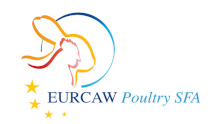Document type: scientific article published in Poultry Science
Authors: Kwon Byung-Yeon, Lee Hyun-Gwan, Jeon Yong-Sung, Song Ju-Yong, Kim Sang-Ho, Kim Dong-Wook, Kim Chan-Ho, Lee Kyung-Woo
Preview: The present study was conducted to assess the animal welfare status of broiler chickens raised in conventional and welfare-certified farms. One conventional farm (30,000 birds/house, 1,488 m2/house, 2 houses) and one animal welfare-certified farm (32,000 birds/house, 1,920 m2/house, 2 houses) were selected to measure productivity, stress responses, and animal welfare indicators in 3 broiler flocks (2 farms/season, n = 6 flocks/farm type) during summer, autumn, and spring. Upon farm visits, body weight, uniformity, and animal welfare indicators (i.e., fecal and feather corticosterone, footpad dermatitis, hock burn, feather dirtiness, and gait score) were measured at 26 d posthatch. Also, moisture, nitrogen, and pH of litter, light intensity, ammonia concentration, and body surface temperature of head, chest, and legs were measured. There was no difference in body weight and uniformity between farm types. Fecal corticosterone concentrations were higher (P = 0.021) in welfare-certified vs. conventional farm, but no significant difference was found in feather corticosterone. Welfare-certified vs. conventional farm had lower percentages of hock burn (P = 0.018), feather dirtiness scores (P = 0.009), and gait score (P = 0.040), and there was no difference in footpad dermatitis. Nitrogen content in litter samples tended to be higher in conventional vs. welfare-certified farms (P = 0.094), and there was no difference in moisture and pH between farm types. Ammonia concentration within the broiler houses was not different between 2 farms. However, animal welfare farm was found to be brighter than conventional farm (P ≤ 0.001). The body surface temperature of head, chest, and legs was not different between farm types. In conclusion, the welfare-certified farm had higher welfare measures, including lower hock burn, feather dirtiness, and gait score, confirming an overall improvement in welfare indicators. However, the observation on the elevated feather corticosterone noted in welfare vs. conventionally raised chickens warrants further studies.




